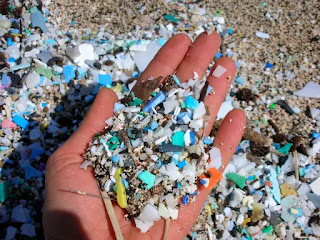Plastics are important materials, and there is essentially no chance that we can get along without it. Everything from our food packaging to our clothes to our electronics depends on them. However, if they are not properly disposed of or recycled, they can persist for long periods in the environment and can also degrade into small pieces that are of concern – microplastics.
Microplastics are very small particles of plastic material. They can be unintentionally formed through the wear and tear of larger pieces of plastic. They can also be deliberately manufactured and intentionally added to products for a specific purpose, for example, as exfoliating beads in facial or body scrubs or as glitter in make-up. Once released to the environment, they may be accumulated by animals, including fish and shellfish and consequently eaten as food by us.
The problem is that we have no way to dispose of much of it. Over 80% of all the plastic that has ever been produced is sitting in landfills or making its way back into the natural environment. As it finds its way into the oceans it is consumed by marine life and, eventually, by people. But the problem of microplastics is not so much that plastic continues to be produced and is so widely used as it is the single-use lifestyle we have gotten used to.
Want some ideas for ways in which you can help? Here are a few from Nutrition Action, the health and nutrition newsletter from the Center for Science in the Public Interest.
The biggest impact you can make is to try to avoid single use plastic products as much as possible. This doesn't mean doing without, just actively looking for alternatives and for ways to reuse plastic products meant for single use and disposal. For example, consider your grocery and produce bags. Could you use a reusable bag instead? When you buy in bulk, can you get products packaged in metal, glass or cardboard instead of plastic? How about reusing those plastic water bottles?
Instead of plastic bags, try using glass containers to store food. Or, when that isn't practical, reusable plastic storage containers instead of bags. Sandwiches? Wrap them up in waxed paper.
Plastic straws are one of the worst problem plastics. Use paper ones. Or just go without.
One place you are not likely to consider when trying to cut back on plastic disposal is your laundry. Each load of laundry you do can release hundreds of thousands of plastic microfibers. The filter on your washer can prevent 70% to 80% of the particles from going down the drain but you still have to dispose of them when you clean the filter. As you replace your clothing, buy natural fibers. And maybe wash less often.
Take a day and just make a conscious effort to notice all of the single use plastics that you cross paths with. Do you really need it all? Is there something you can do to use less?
When I was a child, and dinosaurs roamed the earth, we managed to bring groceries home in paper bags. Soda came in glass bottles. Meals were cooked in ceramic or glass dishes. We as consumers can have a much bigger impact on resolving this problem than we realize. If we demand materials other than plastic, and we make our buying choices accordingly, industry will respond with more options. We need plastic. But we can do without a lot of it too.




No comments:
Post a Comment